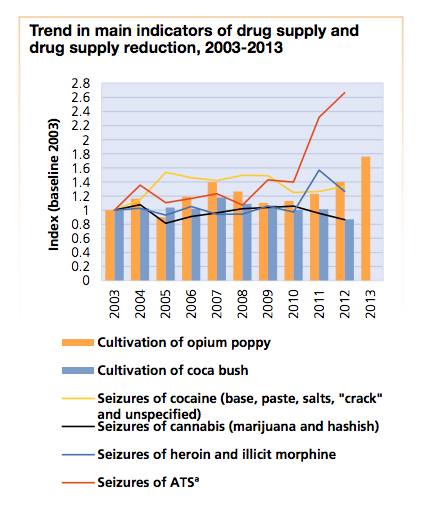
More land was used to cultivate illicit opium in 2013 than ever before, due to increased smuggling through southern Afghanistan, according to the U.N.
The annual World Drug Report released on Thursday indicates that land area used for production of opiates and opioids, the leading cause of drug-related disease and death, reached roughly 733,000 acres last year — the highest since the first estimates were recorded in 1998. For the third consecutive year, Afghanistan has logged the world’s largest opium cultivation.

The increase in global opium production has been attributed to the rising contraband trade of heroin, a derivative of opium poppy. An expanding route along the southern corridor in Afghanistan has facilitated the transport of Afghan heroin to Southeast Asia and Oceania, regions traditionally supplied by Southeast Asia’s opium cultivation. This “southern route” also has bumped up supply to the Middle East, Europe and Africa since law-enforcement officials began cracking down on the long-used Balkan route.
The report arrives amid a global war on drugs, as countries continue to reconsider policies that have failed to lessen illegal drug activity. In Latin America, for example, a region plagued by drug violence, U.S. attempts to suppress drug production have been largely unsuccessful, according to Washington Office on Latin America.
Meanwhile, Russia and the U.S. have maintained their positions on criminalizing illegal drugs, while many Middle Eastern countries have come under fire for imposing capital punishment for drug-related crimes, according to the New York Times. Re-examinations of global drug laws and alternatives to militarized interventions will likely be the crux of the 2016 General Assembly on the world drug problem.
The extent of global drug abuse has remained stable over time at 16 million to 39 million people.
More Must-Reads From TIME
- The 100 Most Influential People of 2024
- The Revolution of Yulia Navalnaya
- 6 Compliments That Land Every Time
- What's the Deal With the Bitcoin Halving?
- If You're Dating Right Now , You're Brave: Column
- The AI That Could Heal a Divided Internet
- Fallout Is a Brilliant Model for the Future of Video Game Adaptations
- Want Weekly Recs on What to Watch, Read, and More? Sign Up for Worth Your Time
Contact us at letters@time.com